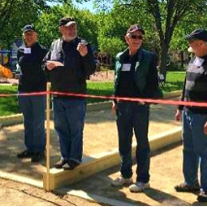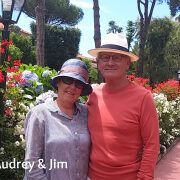People of Linden Hills
“The People of Linden Hills” highlights extraordinary volunteers, interesting neighbors, and the people within the businesses who make Linden Hills the rich and vibrant community it is.
See all of these stories and more
Get the Linden Hills Neighborhood Council E-Newsletter each month.

Constance Pepin, LHiNC Volunteer (May 2021)
By LHiNC Board Member Gina Rautenberg
Whether you know Connie Pepin from the yard and garden tips she shares on Nextdoor, through her work as a founding member of The Friends of Roberts Bird Sanctuary, or via her decade-long commitment to the Linden Hills Neighborhood Council, you surely associate her as a vocal and approachable champion for the environment.
Here’s how Connie went from being a part-time advocate, to taking on a more serious role as a local sustainability and biodiversity leader—and what she recommends that every Linden Hills citizen do, beginning today, to become a better environmental steward.
Connie, within our community, you are the go-to environmental resource. Tell us more about the work you have done locally, and what you are most proud of.
Back in 2005 or so, I became interested in protecting the small remnant woodland between Lake Harriet and Bde Maka Ska, which residents called “Thoreau’s Woods'' because he did actually visit this woodland in 1861. I participated in buckthorn pulls there and later coordinated several “buckthorn busts'' for Linden Hills residents.
I’ve served on LHiNC’s Environment Committee off and on since then. It was a privilege to serve LHiNC as a board member and co-chair during a challenging time for the Council almost 10 years ago.
I am most proud of long-term efforts to protect and preserve our natural areas, including Thoreau’s Woods, Roberts Bird Sanctuary, and sections of the Trolley Path right-of-way, which benefit birds and other wildlife (and people) and improves our environment as a whole.
Today, you're mostly retired from your work as a training consultant. How and when did you begin prioritizing environmental work and advocacy, and how has that work evolved as you've moved out of a full-time professional role?
My mother instilled in me a love of trees, plants, birds and the outdoors, which grew into the joy of hiking, mostly in Minnesota and the UK. I began volunteering in local parks with my daughter over 20 years ago, including Hennepin Parks (now Three Rivers Parks) and Minneapolis Parks. The Eloise Butler Wildflower Garden became my favorite place to volunteer, and I learned from the naturalists there about native trees and plants, as well as invasive species.
The book Noah’s Garden: Restoring the Ecology of Your Own Backyard inspired me to transform my yard into a more natural area for wildlife. Visiting Roberts Bird Sanctuary
expanded my interest in environmental protection, and with other volunteers I co-founded the Friends of Roberts in 2013.
Retirement from the University of Minnesota several years ago gave me even more time to focus on my love of Nature and to become a certified Minnesota Water Steward. I also became more involved with the Audubon Chapter of Minneapolis and now co-chair their Advocacy Committee.
I know you’re very passionate about native plants. Can you tell me what exactly constitutes a native plant or species?
Simply put, native plants are those species that occur naturally in a region in which they evolved, unlike non-native plants that come from other regions (or even other continents) and unlike cultivars or “nativars” which are cultivated to alter their characteristics. Having evolved with native insects, birds and other species, native plants are the ecological basis upon which life depends, including people and other animals.
Planting native species and having a chemical-free yard are two tactics anyone can employ. What do you wish more of our community understood about biodiversity?
I wish more people understood that we can take simple actions to protect biodiversity by restoring the ecology of our own yards and green spaces in our community. The current decline in biodiversity is threatening not only birds and wildlife, but humans and our own ability to maintain our quality of life, and even to survive. Conventional landscaping techniques that further colonize and diminish the landscape with non-native species of trees and other plants are degrading and reducing habitat for pollinators and birds.
You mention that our own quality of life can be greatly impacted by planting more native species. Aside from the benefits that pollinators bring us, what other positive effects do humans see when they prioritize these species in their yards?
Humans enjoy many positive effects when we prioritize native species in our yards. First, native plants are less work to maintain! Once established, they seldom need watering, mulching or protection from the weather. The deep roots of many native plants can help prevent erosion and manage stormwater by infiltrating rain that might otherwise drain into streets and pollute our lakes and rivers.
Native plants are healthier for people because artificial fertilizers, pesticides and herbicides are not necessary. Landscaping with native plants can also help address climate change, as research shows that native trees and shrubs sequester carbon in a more stable manner than exotic ones. By providing wildlife with essential foods (including nectar, caterpillars, nuts, seeds, and fruits), native plants support the life cycles of pollinators, birds and other wildlife, which increase humans' experience and enjoyment of nature around us.
Two books I highly recommend are Nature’s Best Hope by Doug Tallamy and A New Garden Ethic by Benjamin Vogt. Both books explore why our urban wildlife gardens and landscapes matter—for ourselves and for the larger human and animal communities.
To that end, you’ll be leading the 3-year Trolley Path Naturescape project. Can you tell us more about that project, and how Linden Hills residents (or anyone else) can get involved?
The purpose of this project is to enhance biodiversity and ecological function in Linden Hills by planting true native species of trees, shrubs and plants. As much as possible, invasive species will be removed and replaced with native shrubs, sedges, grasses and flowers that benefit pollinators, birds, and other wildlife. We will focus on the Trolley Path right-of-way “Naturescape” between Xerxes Avenue S and Beard Avenue S and on the Pocket Park at 43rd & Upton.
We hope that many volunteers will want to contribute to this effort to replace invasive species with native species and will help sustain the new plantings until they are established.
To volunteer for the Trolley Path Naturescape project, please contact LHiNC's Environmental and Sustainability Committee at enviro@lindenhills.org.

Abdi Sahal, LHiNC Board Member (July 2020)
By LHiNC Board Member Wendy Ponte
Abdikhaliq Sahal, who just turned 23, is the youngest member of the fifteen-person Linden Hills Neighborhood Council (LHiNC). Having a broad range of ages on the board is a real asset for a neighborhood council, but this recent Augsburg University graduate also brings another unique perspective to bear in his council work-- that of his Somali heritage.
Abdi, how long have you and your family lived in Linden Hills, and why did your parents decide to settle in this neighborhood?
We’ve lived here for the last fourteen years. My parents, Aden Ali and Fatuma Kassim, moved our family here from St. Paul because they thought it would be a safe place to raise their children, as well as being a nice neighborhood. There are a few Somali families here in Linden Hills. We try to help each other. My family and I want our Linden Hills neighbors to get to know us.
We live in a part of Linden Hills that is close to Edina. When it came time for high school, my parents decided to send us to Edina High School because they believed there was a better chance of equity there.
What do you like about living in Linden Hills?
I love it for so many reasons, really! I love the businesses, the nature and the water. I love the bike lanes! What I like most about Linden Hills is that everyone here is so open and engaged. Yes, it would be great if it was a little less homogenous, but that takes time.
Tell us about your parent’s choice to immigrate to the U.S.
My parents are originally from Somalia and were living in Kenya. When I was three years old, they decided to move to Minnesota with me and my two younger brothers. They had heard that there was opportunity here from people who had already emigrated.
What do you most appreciate about your Somali heritage, and what would you like us to know about your family?
I love being Somali—I just really love my culture. I love how connected we are to each other and that the closeness is connected to our religion. Being Somali means growing up with the mentality to be a fighter and a survivor because of our country’s history. A Somali looks at the status quo and sees where there can be improvements, because when one of us is hurting, we all are. That’s the future model I see for Linden Hills and Minneapolis too. I was raised to stand up for what I think is right.
The most important Somali value to me is family. My father taught me to take care of my brothers and sisters and to set a good example (I’m the oldest of eight). I know, also, that because I am a black man, I have to be careful about how I portray myself and not to endanger my family.
It sounds like a lot of pressure.
It can be overwhelming sometimes, but I’ve been raised so that I can handle it. Honestly, I probably put most of the pressure on myself. I’ve been blessed by being part of a loving family, and I really want to live up to the expectations they have of me.

I’ve got a mom who has set the example of helping others through her actions. She works full-time for Hennepin County, but she also constantly helps other immigrants, including some new neighbors of ours who just arrived in this country. Our home is a place where anyone can come to look for comfort, because of her.
What made you decide to run for the LHiNC Board?
I was working at the park, and one of my jobs was to set up the room for the monthly board meetings. I found the meetings to be fascinating. I thought it would be a great way to get more involved in the community, but then I realized that I needed to get people to vote for me! I went door to door in the rain to get people to cast a ballot for me, and by chance, I knocked on Frank Hornstein’s door. He walked around with me and decided to endorse me! I’ve learned so much and met some truly exceptional people who serve on the board with me.
So, what’s next?
I’m the first person in my family to go to college, and I just graduated with a degree in Biology. My main focus as an undergrad was to become a dentist, but I’ve been considering different graduate studies now and possibly pursuing a law degree. I had been considering this before the George Floyd murder, but that definitely spurred me on to think more about that possibility.
For sure I plan on working to rebuild the city of Minneapolis and engage in my fellowship work.
I also want to say that this period in our city’s history is exciting because I think it will promote radical love and radical change in our future. But when you think about it, there’s nothing really radical about love. I’m excited for the future of this city and for Linden Hills.

Jon Flanagan, Linden Hills Librarian (April 2019)
If you have kids and live in Linden Hills, they might already know Jon. For those of you who don’t know him and would like to learn more, here is his story.
Jon, when did you know that a library was in your future, and how did the Linden Hills library fit into that plan?
I was raised in a family of avid readers. There was no television in the house until I was in high school, because my mother wanted me and my brothers to focus on books. Libraries were an important part of my life from
a very young age.
During college, I got my first library job, and almost immediately saw it as a viable career path. I love working with the public (particularly children), and truly believe that public libraries are an essential part of our communities.
I was lucky enough to return to Hennepin County Library in 2017, and get a dream job in Linden Hills one mile from my home!
The neighborhood kids know you as “Mr. Jon”. How did that come about?
I'm blessed to be able to present “Storytime” to children and their caregivers, helping to foster a love of books and libraries in the youngsters, while sharing early literacy knowledge with adults. At some point, children started calling me "Mr. Jon," and it stuck. Children's librarians and teachers have a fair amount in common, so I think it makes sense.
You have been a fixture working on the Linden Hills Festival book sale, and, you are going to miss the next one coming up May 19. Will you tell us about this?
The Friends of the Linden Hills Library is a volunteer-run organization that supports the library through volunteering, fundraising, and serving as ambassadors for the library. The biggest Friends event of the year is the annual used book sale at the Linden Hills Festival.
Thousands of wonderful books for all ages will be available, with 100% of the proceeds going to the library. The Friends are always looking for new members, if anyone out there is interested. (www.supporthclib.org/linden-hills)
Unfortunately, I will not be participating in this year's Linden Hills Festival, as my family is relocating to Colorado. It is the right decision for us, but I am also quite sad to be leaving the Linden Hills community.
Will the new "Storytime" librarian be introduced at the Festival?
What I can tell you is this: a talented librarian will be performing a fun “Storytime” at the Linden Hills Festival. There will be friendly library staff hosting an informational table, and our Friends organization will be running a giant used book sale. I don't know if my replacement will be on board by May 19, however.
Jon, your Linden Hills friends and neighbors wish you and your family all of the best that Colorado has to offer!

Jäger of Settergren’s Ace Hardware (January 2019)
Speaking for Jäger is Joe Young
Did you ever walk into a store and observe an employee in action and think wow what a “Pro”? That’s exactly what hit me when I went to interview Jäger for this article. I’m Carol Clemens, editor of LHiNC E-News, here’s his story.
Jäger, I understand you are the official greeter, treat taster, morale officer, and guard dog for Settergren’s Ace Hardware in Linden Hills. How did you get into this line of work and how long have you been at it?
I’ve done it since was I was just a pup. Like most hardware men it’s in my blood.
Were there competitors for your position? Did special training and/or education help you land the job?
(Laughs) – No. No one can compete with me!
Please tell me a little about yourself and what do you do in your free time?
I am a 12-year-old Large Muensterlander. On my days off, I love to hunt pheasants and grouse, swim up at the cabin, and fish. I was told I could be the mayor (dog) of Linden Hills. Many of my dog friends come in daily to visit and quite a few people come in just to see me (he laughs) maybe I am the mayor!
Did you choose Linden Hills or did Linden Hills choose you?
A little bit of both. Linden Hills is a great place for dogs. And lots of people who come in the store have treats in their pockets.
Settergren’s is a family business, an institution in Linden Hills. What would you say is your biggest contribution to the success of the Linden Hills location?
I add to the whole experience. Who doesn’t love seeing a dog at the hardware store?
Will the Minneapolis minimum wage affect your situation at Settergren’s? What are the daily challenges you face in your job?
No, I’m paid in dog treats. But I would do this for free! As far as challenges, I’d say sometimes I want to follow other dogs out. But I have to stay and work. Also cats can be a problem. There is this big one who wanders in the store from time to time. I don’t like that.
Do you just interact with customers or do you also look after the store personnel?
I interact with everyone, especially the people who give me treats. And kids. I love the kids! I also try keeping Joe from getting stressed out when it’s really busy.

Lisa MacMartin (September 2018)
“Heartfelt,” a cozy-one-of-a-kind shop in the center of the Linden Hills Village, has been a business supporter of the village since 2011. Owner Lisa MacMartin stocks a unique selection of natural gifts, toys and crafts, as well as offering inspiring and unusual craft classes.
Our new People of Linden Hills contributor, Sarah Kinkeade from Bremer, caught up with Lisa to get to the “heart” of this master crafter and Linden Hills treasure.
Heartfelt is such a niche store. Where did the idea for this fun concept originate?
Arts and crafts have always been an important part of my life. I started Heartfelt as a toy and craft store. One Christmas, the finances were really lean; limiting the amount of inventory I was able to purchase. I came up with a promotion “make your own holiday gifts.” It just took off from there. The making and crafting are now central to the store, as are our weekend birthday parties.
Why did you choose Linden Hills?
I chose Linden Hills, because the core focus of this area is children and families, and since I also lived in the area, it felt like home.
In addition to running Heartfelt, you are also the current president of the Linden Hills Business Association, which has been revitalized under your tenure. Why did you take on that challenge?
Projects are always more fun when you do them together. After a few years in business, I felt that for the success of my business and my neighbors’ businesses we needed to work together. You put your money and dreams on the line for your business, and when you have an association, you can support each other.
Your tenure as President of LHBA is coming to an end. What do see for the future of the LHBA?
I hope that newer members and businesses see the value in it. I hope that the culture develops, so more Linden Hills business owners get involved and task ‘what can I do to help’.
In closing Lisa said… “I feel truly blessed—I have the best job in the world. Not only is crafting soothing, it can bring families and groups together to create community. And that is what Heartfelt is all about.”

“The Bocce Boys” (August 2018)
Bocce Courts in Linden Hills Park? Absolutely. Spearheaded by the efforts of four local long-time residents Dale Mulfinger, Marc Burgett, Steve Benson, and Rick Polanski.
Sarah Kinkeade of Bremer had an opportunity to catch up with Dale to learn more about his team and the new courts.
Where did the bocce connection come from?
We’ve been friends for many years and frequently meet for coffee and one thing led to another… we took up playing bocce ball in Linden Hills Park on the grass or on vacant baseball infields.
What made you decide to pursue “Official Courts” Linden Hills?
A few years ago we heard about the bocce courts at Beltrami Park. We were blown away by the shear pleasure of playing on ‘real’ courts. We were amazed at the size of their leagues. We walked away saying, “Why can’t Linden Hills have something similar?”
The four of you have really put a lot into making this dream a reality.
It really has been a process. We met with the Park Board to confirm a site and attended various community meetings to gain support as well as creating design ideas for the space.
We had a goal of being open for the Linden Hills Festival. A couple of April snows threatened to push progress back but between a lot of shoveling and sweat equity from neighbors the courts opened on time.
It sounds like this has been a testament to the community coming together for a common goal.
Absolutely. We received generous grants from organizations such as LHiNC, the Minneapolis Park Board, People for Parks, Bremer donating space for an event, Settergren’s donating bocce sets for community use and the countless neighbors volunteering their time to make it all happen.
Any funny bocce ball stories to share?
The funniest came during construction with people asking “Do you think these are a little long for badminton courts” or “Why are you organizing archery lanes so close to the kids play area?”
If people are looking to play bocce who should they contact?
If people want to join a league they should contact Marc. Bocce balls are also available onsite during non-league play and can be checked out at the Linden Hills Rec Center.
Karen Lang, resident and owner of grace & co. (July 2018)
Did you ever wonder how someone decides to pursue their passion and make it their occupation? Karen Lang, Linden Hills resident and the owner of grace & co., has an intriguing story to tell about her enterprise. grace & co. is a charming gift shop featuring locally made jewelry, vintage and repurposed home furnishings, pillows, soaps, candles, Muddy Mouth Cards, and Autumns Vintage Clothing. The shop is located on the second floor at 4317 Upton, in the heart of Linden Hills.
Jen Bellefleur of New Gild Jewelers visited Karen and asked a few questions about her career path.
What was your first job?
I was a flight attendant. I love people and I love to travel. I still find myself pointing out directions to people with that flight attendant straight-arm point.
Do you have a mentor or a personal hero?
I am very self-taught in all I do… I would say in a modest way I am my own hero.
How did grace & co. come about?
This all unfolded a step at a time and I followed.
I walked into The Bead Monkey in Edina 15 years ago and instantly became irrevocably enamored with all things sparkly. That day became the first day of the rest of my life as I slowly pursued my passion. I didn’t take any classes in beading or business but here I am. I love sharing my story.
I heard you once had your grace & co. jewelry in a very important Hollywood swag bag, can you tell us about that?
In 2003, my jewelry was featured in all the Oscar swag bags given to everyone up for awards. My jewelry was also featured on another show we all watched: THE BACHELOR.
What is something about you that is reflected here in your shop?
I absolutely adore visiting with the people who come in. I love to spread my humor and ”joie de vivre” every chance I get…and of course; design and create jewelry.
What’s the most unusual thing you’ve seen on the streets of Linden Hills?
This neighborhood is the most friendly and charming hood I have ever lived in And, I am grateful everyday to be able to live and work here; I feel like I live in Mr. Rogers Neighborhood!

Kick Car Ownership to the Curb? (March 2017)
By Carol Clemens
It’s not for everybody. It falls under the category of “lifestyle” change. Audrey Dammer and Jim Boyer started this adventure making two decisions: move from the suburbs back home to Linden Hills, and plan a six-month trip to live in Florence, Italy. Success on both fronts. (Sold their two cars before they left so they didn’t have to worry about storage.)
In Florence they walked miles daily, took buses and hi-speed rail and didn’t even think about driving a car. Their trip of a lifetime. They even adopted the Italian tradition of passeggiata (“little walk”) before dinner that they equated to early evening strolls around Calhoun and Harriet.
Six months later, back in Linden Hills, the first thing they did transportation-wise was get a Metro Transit card. By now walking daily was an enjoyable habit — one day walking over to Settergren’s on W. 43rd St, they noticed an HOURCAR parked near the front entrance. They checked things out and found how simple it would be to have a car available when they needed it through the HOURCAR car-sharing program.
They signed up and became HOURCAR members.
Audrey said the key to getting around without owning a car is planning: what transportation mode, what to wear, how much you can carry, how much time you will need, and making your reservations for HOURCAR usage.
Jim and Audrey use HOURCAR one to two times a week. They also walk, use buses, bikes, LRT, and ride sharing services. Jim said it was easy to make the decision not to buy a car, but this doesn’t mean they won’t ever change their minds.
lh hourcarIn 2012, LHiNC made a financial investment and worked to attract the HOURCAR program to place a car in the neighborhood. Five years later the car-sharing model remains popular to those looking for alternatives to car ownership. Look for the light blue Toyota Prius at its hub in the parking lot at Settergren’s Hardware.
Anyone can become an HOURCAR member and use the car for a flat rate of $8.50 per hour. Gas and insurance are included at no additional charge.